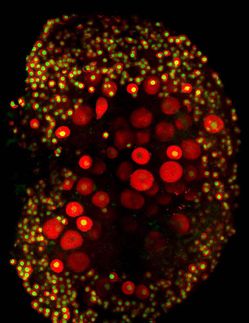HSAN 1: identification of new mutations can lead to more accurate diagnosis and improved genetic counseling
VIB researchers at the University of Antwerp have identified several mutations that play an important role in the development of Hereditary Sensory and Autonomous Neuropathy Type 1 (HSAN 1). HSAN 1 is a rare genetic disorder of the peripheral nervous system. Identification of the mutations will lead to a more accurate diagnosis of the disease in patients as well as improved genetic counseling and prenatal diagnostic tests for couples who are carriers and planning a pregnancy.
Hereditary Sensory and Autonomous Neuropathy (HSAN) refers to a group of hereditary disorders of the peripheral nervous system. HSAN primarily affects the sensory nerves, leading to a loss of feeling in the hands and feet. However, it can also affect the autonomous nerves, which are responsible for such functions as blood pressure control and sweat production.
The course of the illness in HSAN patients varies greatly and is divided into six subtypes. The symptoms of HSAN 1 appear during adolescence or adulthood. In addition to pronounced sensory disturbances, patients may also suffer to a certain extent from muscle weakness and atrophy of the feet, hands and lower legs due to damage of the motor nerves.
Genetically speaking, HSAN is extremely heterogeneous. To-date mutations in nine different genes have been described, but studies have shown that there are other HSAN-causing genes remaining to be discovered. Annelies Rotthier and her colleagues conducted a DNA study on 78 HSAN patients under the leadership of Vincent Timmerman and in collaboration with researchers in other countries. They looked for mutations in the second subunit of palmitoyltransferase (SPTLC2) protein. Three different mutations in four patients were identified.
Based on what they observed in both cells from patients and genetically modified yeast cells, the researchers were able to demonstrate that the identified mutations led to decreased activity of the SPT enzyme. The mutated enzyme also proved to result in an accumulation of toxic molecules in the cell. Future research will determine whether lowering the concentration of these toxic molecules could serve as a therapy for HSAN patients.
The significance of these findings is twofold. First and foremost, the discovery of mutations in another gene is important for HSAN patients, since they can now be screened for SPTLC2 mutations. This will improve diagnostic accuracy, which is important for evaluating the prognosis of the patient, as well as facilitate genetic counseling and prenatal diagnosis.
These results also contribute to our understanding of the activity of the peripheral nervous system in both sick and healthy people. Although HSAN is rare, the disease mechanisms that have been uncovered by this study could be of major significance for other disorders of the peripheral nervous system, such as the neuropathies associated with diabetes and chemotherapy. The latter may occur much more frequently than HSAN but their underlying disease mechanisms are still largely unknown.
Original publication: Rotthieret al., “Mutations in the SPTLC2 subunit of serine palmitoyltransferase cause hereditary sensory and autonomic neuropathy type 1”; American Journal of Human Genetics 2010.
Other news from the department science

Get the life science industry in your inbox
By submitting this form you agree that LUMITOS AG will send you the newsletter(s) selected above by email. Your data will not be passed on to third parties. Your data will be stored and processed in accordance with our data protection regulations. LUMITOS may contact you by email for the purpose of advertising or market and opinion surveys. You can revoke your consent at any time without giving reasons to LUMITOS AG, Ernst-Augustin-Str. 2, 12489 Berlin, Germany or by e-mail at revoke@lumitos.com with effect for the future. In addition, each email contains a link to unsubscribe from the corresponding newsletter.






















































